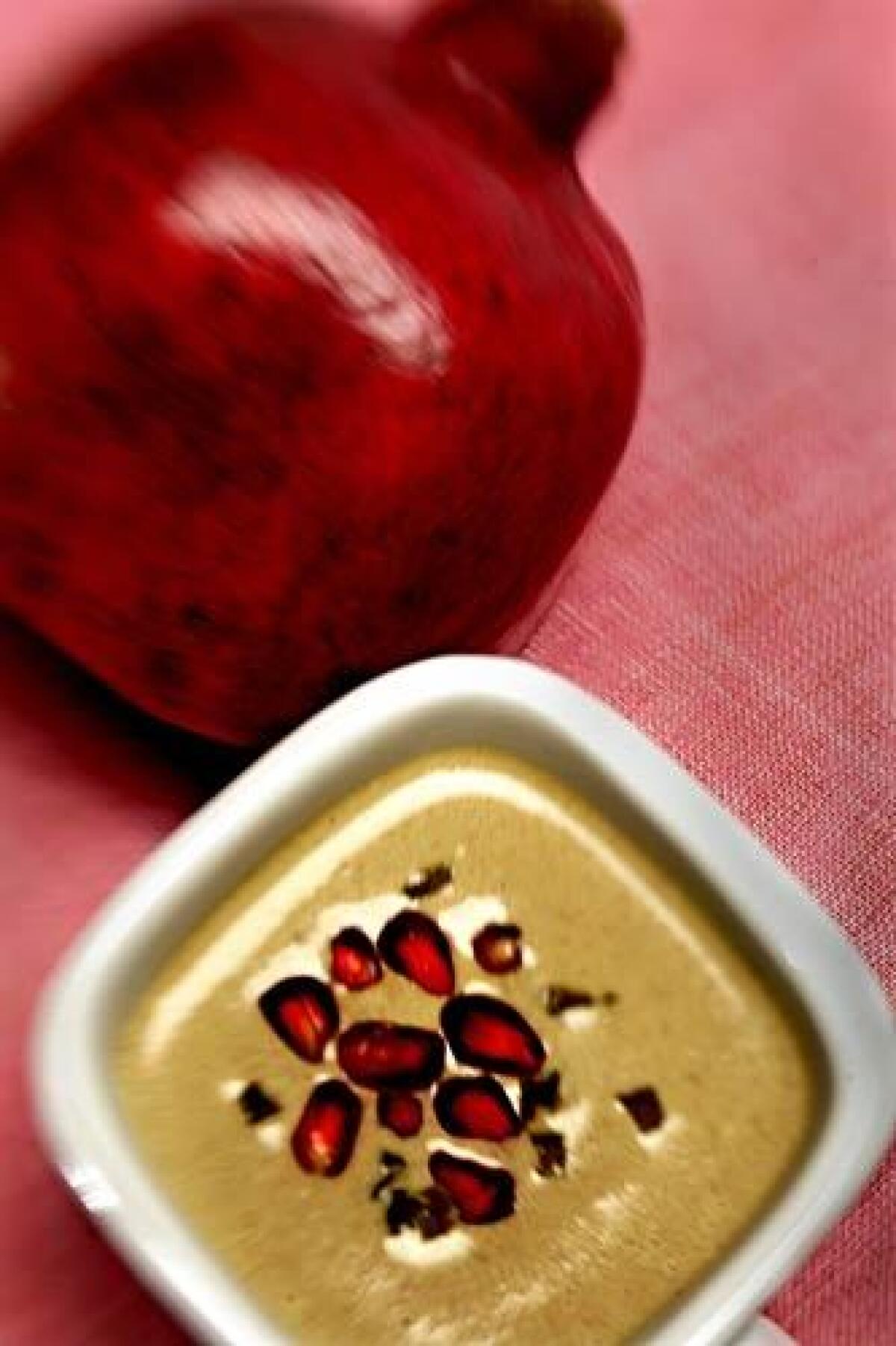Back to the pomegranate

- Share via
Even in a world where food trends cycle in and out faster than art-house films at a multiplex, the career trajectory of the pomegranate has been dazzling.
Only three years ago it was a relatively esoteric fruit in this country. Then it became the juice equivalent of oat bran, then the flavor du jour of the beverage case. And now it is being made into a liqueur -- Pom to Poma in less time than it takes to age a decent white wine.
What got lost in all of this forced trendiness was the original, relatively esoteric fruit, which really is one of the glories of late summer and early fall. Juice has made it more accessible, but the crimson seeds of the fresh fruit have a crystalline beauty and singular crunch well worth exploring. You don’t have to drop $5 for an over-designed pint bottle at the supermarket.
Admittedly, pomegranates are intimidating. They are the crabs of the produce aisle, wondrous to eat but a messy hassle to break down to extract that wondrousness. Since they have such a short season, though, the pleasure outweighs the pain. They never get to be a routine.
And the rewards are endless. Pomegranates are tart and crisp, which is the least you expect in fall fruit. But they are also dramatic in a way no apple or pear could ever hope to be. A handful of seeds tossed into a mesclun salad with blue cheese can elevate the whole eating experience, with color, texture, flavor and drama.
The seeds can also make a statement in soups. They’re the ultimate seasonal garnish.
The trick is just to flick every seed out without catching any of the exceptionally bitter yellow pith around it. Luckily, the seeds are contained in fairly fat compartments inside each pomegranate and you just have to open the whole thing and prize them out. If you do that over a bowlful of water, the good stuff sinks and the bitter bits float, making it easier to separate the two.
Making juice from fresh pomegranates is also easier than it looks. “Chez Panisse Fruit” by Alice Waters and her team suggests a simple technique: Break open the pomegranate (with a knife if you must) and carefully separate the seeds. Using either an immersion or regular blender, liquefy the seeds and strain the juice through a sieve. “Viola!” as they say on the blogs. Two to three heavy pomegranates should yield a cup of juice.
This is a very different product from what you can buy bottled. It’s thinner and naturally tarter. But even the Pom juice will work in most recipes. Most other brands seem to be the pomegranate cousin of cranberry juice cocktail, more grape juice and high-fructose corn syrup than the fruit on the label.
The juice and seeds are also very different from what Southern Californians can expect from pomegranates growing in the backyard. Most of those bushes are ornamental, and although they do yield gorgeous flowers and fruit, the latter are usually waxy rather than succulent.
Pomegranates sold in stores are generally California-grown, with different varieties available from September through December.
What are widely available now are Granadas, which have light-red skins and are not super-sweet; in a few weeks the seductively named Wonderfuls will arrive, the familiar large, deep-red fruit that grow progressively sweeter as the cold sets in later in fall.
You can also sometimes find boxes of pomegranate seeds at Trader Joe’s or Whole Foods, but those we tasted weren’t as fresh and flavorful as seeds popped straight from the fruit.
Pomegranates tend to get either scarce or pricey around the Jewish holidays, which can be taken as a sign of how prized they are in Middle Eastern cooking. But Mexican cooks are just as taken with them, matching the fruit with the same partner Persians and others choose: walnuts. Chiles en nogada is a spectacular pairing of picadillo-stuffed poblanos in a creamy walnut sauce with pomegranate seeds as a dramatic garnish. The flavors work so well together that they can be transformed into a soup, with the chiles both in the base and as a garnish.
Pomegranate juice and seeds can make tapioca taste new. The tartness cuts the richness, and the crunchiness of the garnish of seeds plays off the soft chewiness of the tapioca pearls.
And for anyone who thinks duck deserves better than orange juice and other syrupy sweetness, pomegranate works wonders. An old recipe for succulent duck legs from Bay Wolf restaurant in Oakland works even more brilliantly with pomegranates than with red wine. The legs are roasted, then braised so that the skin turns super-crispy and the flesh is sublimely tender and aromatic.
No matter how you use it, it’s worth noting how the pomegranate evolved from exotic to everyday. Since 2002 Pom Wonderful, the Los Angeles-based company that turned an ornamental fruit into a household word, has reportedly invested $10 million and counting in studies it hopes demonstrate that the product is the secret to eternal health if not life.
The kumquat should only be so lucky.
More to Read
Sign up for The Wild
We’ll help you find the best places to hike, bike and run, as well as the perfect silent spots for meditation and yoga.
You may occasionally receive promotional content from the Los Angeles Times.










